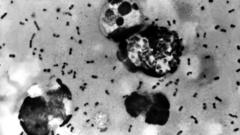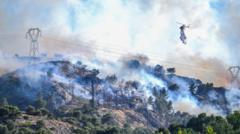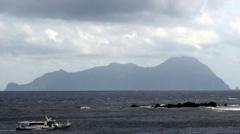Authorities are investigating what has caused the sudden transformation of a stream into a vivid crimson, attracting attention due to its potential link to ongoing pollution issues in the region.
### Mysterious Color Change of Stream in Buenos Aires Raises Pollution Alarms

### Mysterious Color Change of Stream in Buenos Aires Raises Pollution Alarms
Residents in Sarandí shocked as a stream turns an alarming red, sparking fears of hazardous waste in the water.
In the serene suburb of Sarandí, just south of Buenos Aires, an unsettling event occurred this week as a local stream inexplicably turned a bright red hue. This phenomenon raised immediate alarm among residents who fear the change may be caused by harmful industrial pollutants from nearby factories, particularly tanneries. Witnesses reported a foul odor reminiscent of garbage, which fueled anxieties about the stream’s safety.
Local news sources highlight that this stream ultimately flows into the significant Río de la Plata, a vital waterway that serves as a natural border between Argentina and Uruguay. The area nearby has a well-documented pollution legacy, with the Matanza-Riachuelo River basin notoriously recognized as one of Latin America's most contaminated waterways. While officials have previously embarked on several initiatives aimed at cleaning up these rivers, this new incident has reignited concerns over the adequacy of these measures.
The environmental ministry of the Province of Buenos Aires stated that staff responded promptly to complaints of the red stream and collected water samples for analysis. Preliminary assessments suggested that the peculiar coloration could stem from "some type of organic dye," although definitive results have yet to be issued.
Maria Ducomls, a long-time resident, described her jarring experience upon noticing the stream’s vibrant transformation and the accompanying odorous emanation. “It looked like a river covered in blood,” she recounted, lamenting the frequent peculiar colors the stream has exhibited over the years — ranging from blue to green, and even purple — often accompanied by oily sheens.
Experts and environmental advocates stress that the crisis underscores systemic issues related to regulatory failures in the region. Moira Zellner, a professor familiar with Buenos Aires's history of pollution, attributed the recurring problems to "chronic lack of regulation and lack of enforcement." She expressed disappointment but not surprise at the stream's alarming color, citing a long-standing history of environmental neglect in the region.
Carlos Colángelo, head of the Professional Council of Chemistry for the Province of Buenos Aires, echoed concerns over the potential discharge of harmful chemicals. He indicated that the investigation would reveal more about accountability and usage of hazardous materials. “We have to wait for the results of the analysis,” he stated, cautioning against irresponsible practices that could lead to such an environmental debacle.
This incident has undoubtedly amplified the dialogue regarding environmental protection and regulation in Buenos Aires, as the local community awaits further clarity on the causes behind the alarming transformation of their stream.
Local news sources highlight that this stream ultimately flows into the significant Río de la Plata, a vital waterway that serves as a natural border between Argentina and Uruguay. The area nearby has a well-documented pollution legacy, with the Matanza-Riachuelo River basin notoriously recognized as one of Latin America's most contaminated waterways. While officials have previously embarked on several initiatives aimed at cleaning up these rivers, this new incident has reignited concerns over the adequacy of these measures.
The environmental ministry of the Province of Buenos Aires stated that staff responded promptly to complaints of the red stream and collected water samples for analysis. Preliminary assessments suggested that the peculiar coloration could stem from "some type of organic dye," although definitive results have yet to be issued.
Maria Ducomls, a long-time resident, described her jarring experience upon noticing the stream’s vibrant transformation and the accompanying odorous emanation. “It looked like a river covered in blood,” she recounted, lamenting the frequent peculiar colors the stream has exhibited over the years — ranging from blue to green, and even purple — often accompanied by oily sheens.
Experts and environmental advocates stress that the crisis underscores systemic issues related to regulatory failures in the region. Moira Zellner, a professor familiar with Buenos Aires's history of pollution, attributed the recurring problems to "chronic lack of regulation and lack of enforcement." She expressed disappointment but not surprise at the stream's alarming color, citing a long-standing history of environmental neglect in the region.
Carlos Colángelo, head of the Professional Council of Chemistry for the Province of Buenos Aires, echoed concerns over the potential discharge of harmful chemicals. He indicated that the investigation would reveal more about accountability and usage of hazardous materials. “We have to wait for the results of the analysis,” he stated, cautioning against irresponsible practices that could lead to such an environmental debacle.
This incident has undoubtedly amplified the dialogue regarding environmental protection and regulation in Buenos Aires, as the local community awaits further clarity on the causes behind the alarming transformation of their stream.






















